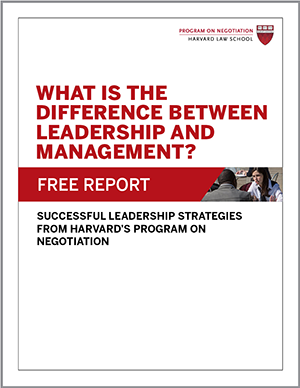
During the Covid-19 pandemic, organizations and their leaders have faced unprecedented challenges that often cannot be fully met by going it alone. The story of how the Biden administration pushed pharmaceutical companies Johnson & Johnson (J&J) and Merck to work together to ramp up vaccine production illustrates how organizational leadership can inspire new forms of collaboration, while also highlighting the role of leadership in negotiation.
Early Setbacks in Organizational Leadership
In August 2020, as part of its Operation Warp Speed initiative to bring Covid-19 vaccines quickly to market, the Trump administration promised to pay J&J $1 billion for 100 million vaccine doses for U.S. residents. J&J went on to develop a Covid-19 vaccine that performed well in clinical trials. The incoming Biden administration planned a huge rollout of the vaccine, which required just one dose and promised to be easier to administer than Moderna’s and Pfizer’s vaccines.
But after Biden took office, frustration set in when J&J said it had fallen behind on its production goals and would be able to deliver only 20 million of the 37 million doses expected by the end of March. Meanwhile, J&J competitor Merck had recently given up its efforts to develop a coronavirus vaccine. The two companies had preliminary talks about Merck helping J&J produce its vaccine, but J&J was hesitant about making a commitment, two senior Biden administration officials told CNN.
A New Legacy and an Implicit Threat
In early February, 2021, White House coronavirus response coordinator Jeffrey D. Zients called J&J CEO Alex Gorsky and asked him to go “big and bold” on the vaccine, according to CNN. Zients reportedly reminded Gorsky, a military veteran, of J&J’s significant contributions to the Allied war effort during World War II. By going all in on its Covid-19 vaccine, Zients said, J&J could build a “new legacy,” two senior White House officials told CNN.
Hanging over that discussion and others was the fact that the U.S. government could invoke the Defense Production Act (DPA) to compel J&J to ramp up production and other pharmaceutical firms to assist in the effort. One senior White House official told CNN that the DPA was never explicitly threatened but was an implicit factor that “brings people to the table and puts people on their toes.”
The call between Zients and Gorsky was a “turning point,” according to one of the officials: After that, J&J and Merck began talking seriously about working together.
A Deal Emerges
On February 27, the U.S. Food and Drug Administration approved J&J’s Covid-19 vaccine for emergency use. And on March 2, Merck revealed it had reached a deal to help produce J&J’s vaccine. The U.S. government agreed to pay Merck up to $268.8 million to adapt its facilities to allow it to fill vials with J&J’s coronavirus vaccine and eventually produce the drug substance used in the J&J vaccine, according to National Public Radio. The White House also invoked the DPA to give J&J access to supplies it needed to produce and package vaccines, according to the New York Times.
On March 3, President Joe Biden announced that the United States was “on track” to supply enough Covid-19 vaccines to every adult in the country by the end of May, two months ahead of schedule, the Times reports. Biden thanked J&J and Merck for “stepping up and being good corporate citizens during this crisis.”
Organizational Leadership in Action
It can be difficult to gauge how to convince organizations to look beyond their self-interests and contribute to the greater good. Organizational leadership often involves drawing on various leadership styles to inspire and motivate others to help you meet your goals.
Visionary leadership: Inspire others to go bold. To persuade Gorsky to fully address J&J’s Covid-19 virus shortfall, Zients drew on his knowledge of the CEO’s military background and appealed to his sense of patriotism. Zients also encouraged J&J’s leaders to imagine how they could contribute to shaping their company’s legacy into the future.
Transactional leadership: Make it worth their while. It would have been unrealistic for the Biden administration to expect Merck to go all in on supporting a competitor’s product without sufficient financial incentives. The White House agreed to help fund upgrades to Merck’s facilities to enable production of J&J’s Covid-19 vaccine.
Strategic leadership: Leverage implicit threats. In negotiation, issuing an explicit threat can create conflict and abruptly end talks. As such, threats should generally be a last-resort option. By contrast, an implicit threat can motivate cooperation without antagonizing your negotiating counterpart. The White House reportedly was able to leverage the possibility of invoking the DPA in its negotiations with J&J and Merck without explicitly threatening to do so.
What organizational leadership challenges have you addressed recently through negotiation?





